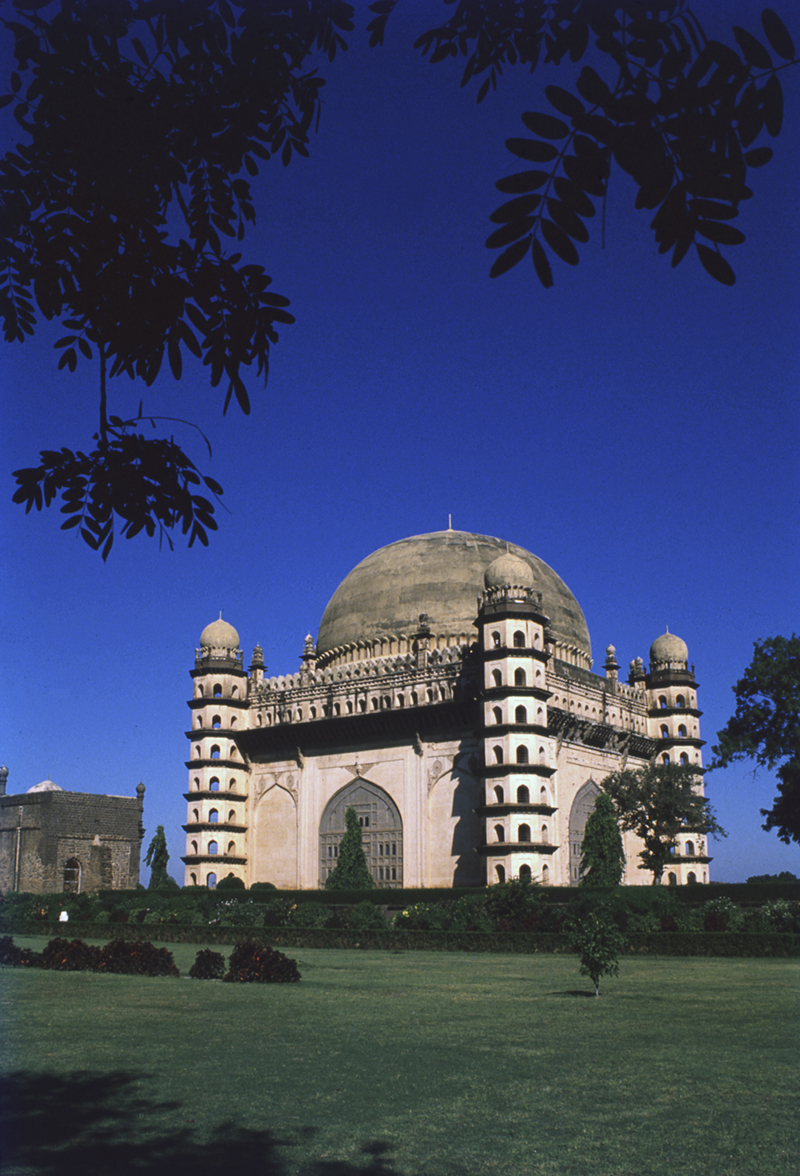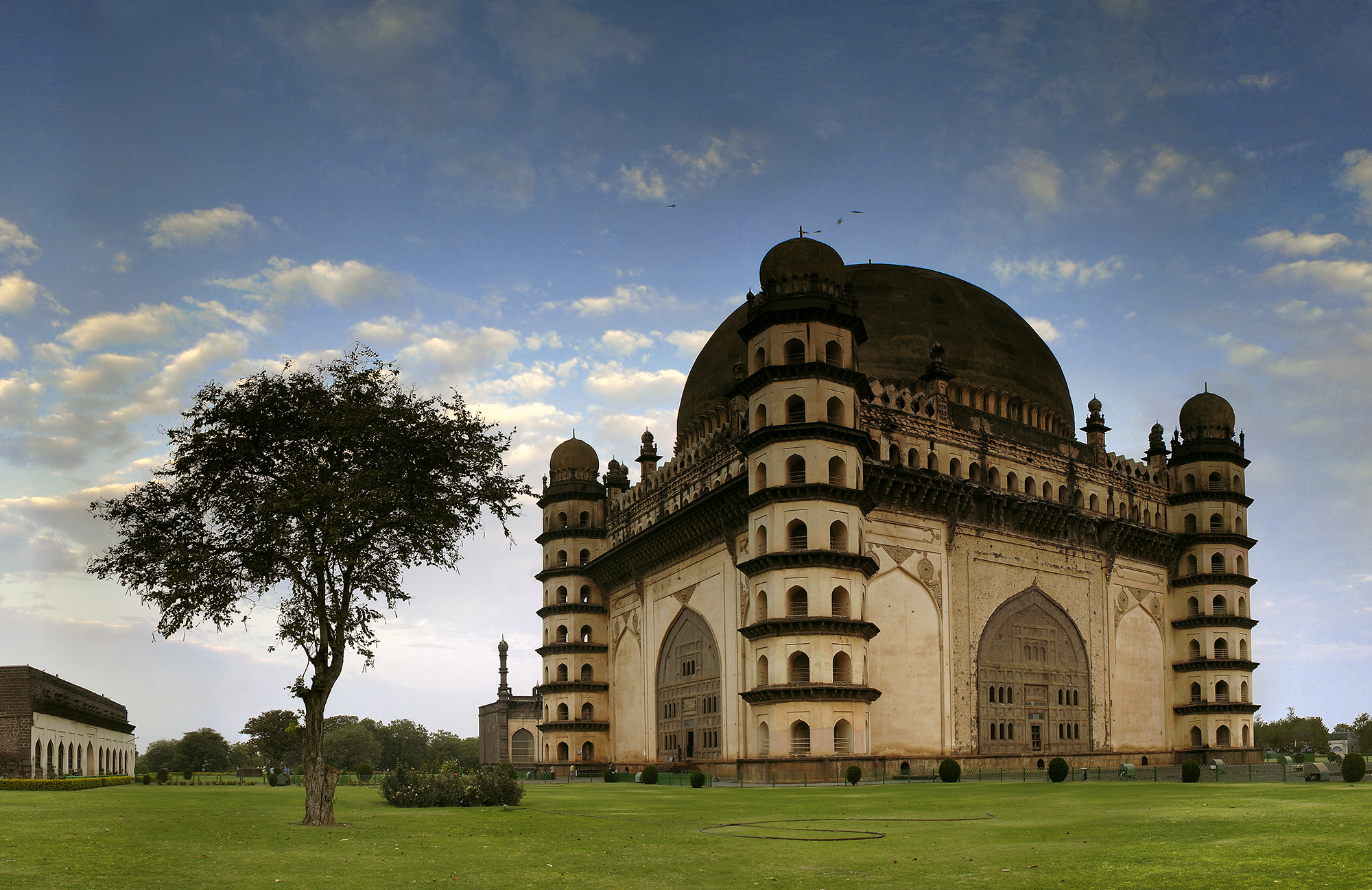ARTICLE
Gol Gumbaz, Bijapur
The large central dome, built of brick and lime, is supported internally by eight intersecting arches. The impressive engineering of the structure is evident in the support developed for the expansive dome, which rests on interlocking square *pendentives that counteract its weight. A similar support structure is seen in the Jami Masjid in Bijapur. Scholars believe this system was inspired by Central Asian architecture of the time. The dome has small openings through its drum, one of which opens to a circular whispering gallery that circles the interior dome on the sixth storey, known for its acoustic properties that magnify sound over ten to twelve times in its echo.
The interior of the mausoleum has a raised platform bearing cenotaphs marking the position of Muhammad Adil Shah II’s grave and those of his wife, mistress, daughter and grandson, all of which are located in the basement below. The cenotaphs are surrounded by a wooden structure consisting of three slender archways on each side, capped by a sloping rectangular roof. This chamber is vaulted with tall pointed arches on its sides, which support the base of the dome.
A pathway links the gateway to the mausoleum to the arcaded Naqqar Khana, a building for drummers and musicians. In 1892, the Naqqar Khana was converted into a museum by the British government to house artefacts procured in the Deccan. In 1912, the museum was placed under the care of the Bijapur district collector. In 1962, it came under the jurisdiction of the Archaeological Survey of India (ASI). The museum collection includes bidriware, sculptures, carpets, coins, manuscripts and miniature paintings.
The Gol Gumbaz is open to the general public, and is maintained by the Archaeological Survey of India.
Bibliography
Brown, Percy. “Provincial Style: Bijapure (16th & 17th Centuries), Khandesh (15th and 16th Centuries).” In Indian Architecture (Islamic Period). Mumbai: DB Taraporevala Sons & Co. Private Ltd, 1956. Accessed June 21, 2022. https://archive.org/details/IndianArchitecture.
Kumar, Shiva N. “Tempting Tales of a Tomb.” The Hindu, March 29, 2015. Accessed June 21, 2022. https://www.thehindu.com/features/metroplus/tempting-tales-of-a-tomb/article 7043586.ece.
Michell, George, and Mark Zebrowski. The New Cambridge History of India: Architecture and Art of the Deccan Sultanates. Cambridge University Press, 1999.
Mondini, Sara. “The Jami Masjid Miḥrāb of Bijapur: Inscribing Turkic Identities in a Contested Space.” In Turkish History and Culture in India, edited by A. C. S. Peacock and Richard Piran McClary. Leiden and Boston: Brill, 2020.
Raghubans, Kishore. “Deccan Sultanate Water Works at Bijapur with Special Reference to Gol Gumbaz and Ibrahim Rouza.” Heritage: Journal of Multidisciplinary Studies in Archaeology 2 (2014). Accessed June 21, 2022. http://surl.li/ciqvd.
Rozindar, Firoz. “Gol Gumbaz Museum Preserves Slice of History.” The Hindu, May 18, 2015. Accessed June 21, 2022. https://www.thehindu.com/news/national/karnataka/gol-gumbaz- museum-preserves-slice-of-history/article7217911.ece.
Safvi, Rana. “Shock and Awe in a Mausoleum.” The Hindu, August 19, 2018. Accessed June 21, 2022. https://www.thehindu.com/opinion/columns/shock-and-awe-in-a-mausoleum/ article24726821.ece.











